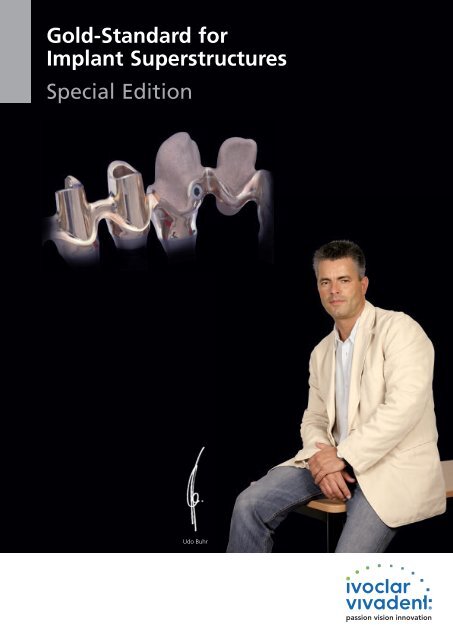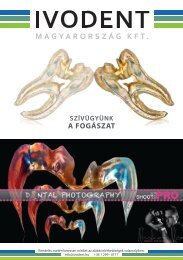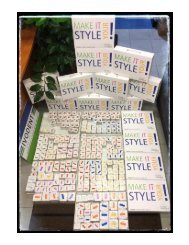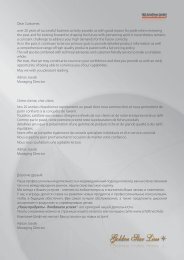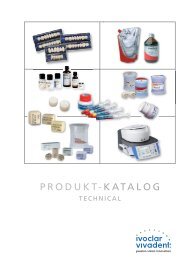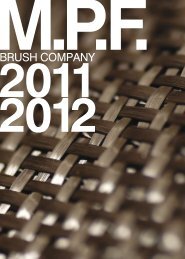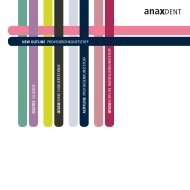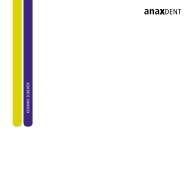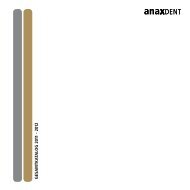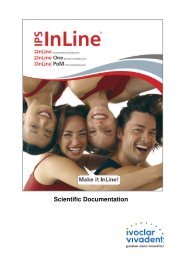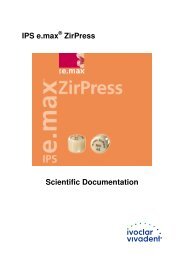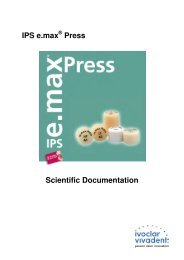Create successful ePaper yourself
Turn your PDF publications into a flip-book with our unique Google optimized e-Paper software.
<strong>Gold</strong>-<strong>Standard</strong> <strong>for</strong><br />
<strong>Implant</strong> <strong>Superstructures</strong><br />
<strong>Special</strong> <strong>Edition</strong><br />
Udo Buhr
Comparisons, like allegories, result in different things being<br />
compared to each other leading to new approaches.<br />
Even the "micro-cosmos dental technology" does not remain untouched.<br />
The signs of the time point towards metal-free restorations.<br />
Does dental technology lose its old operating system, i.e. the<br />
precious metal technique?<br />
In dentistry, gold in many variations is a material that has been used<br />
<strong>for</strong> more than a hundred years. <strong>Gold</strong> alloys have been clinically<br />
investigated again and again since that time and always scored outstanding<br />
results with regard to compatibility and durability. That is<br />
why gold alloys and thus the precious metal technique will stay<br />
around <strong>for</strong> the future.<br />
It will be decisive, however, how this mixed material is processed.<br />
Not least because precious metal alloys are medical products, their<br />
processing must be mastered. After all, the well-being of the patient<br />
and the corresponding com<strong>for</strong>t of wear exhibited by our anatomical<br />
reconstructions are in the <strong>for</strong>eground.<br />
2
Discourse on techniques<br />
The processing of mixed materials known as "precious metal<br />
alloys" is very complex and directly depends on the technical<br />
indication. Well-founded knowledge of all the disciplines of<br />
material processing is further promoted by a pronounced<br />
willingness and enthusiasm to learn new things and<br />
implement them accordingly.<br />
The complex processing steps have to be supported by a high<br />
per<strong>for</strong>mance level as far as the casting technique is<br />
concerned. The precision is confirmed by the excellent<br />
accuracy of fit of all framework indications without having<br />
to sacrifice the creative design of the framework.<br />
This results in a set of important parameters required to<br />
ensure the permanent reproducibility of precise casting<br />
results.<br />
3
Model situation<br />
Model fabrication<br />
The basis of each working procedure in the dental laboratory is<br />
an outstanding and reliable base or master model. For the<br />
fabrication of this implant-retained restoration, the model<br />
analogs (RN synOcta <strong>Gold</strong> coping) are used in conjunction<br />
with plastic modelling aids. The situation on the stone model<br />
exactly represents the implant position in the oral cavity. The<br />
transfer of the model analogs is achieved with the help of what<br />
is known as passive splinting. This is already a significant aspect in the examination and<br />
discussion of the dimensional stability of impressions.<br />
The representation of the soft tissue structure indicates the course of the gingiva in the oral<br />
cavity. The model analogs, on which the 1.5 mm RN synOcta secondary parts are mounted,<br />
represent the starting situation. The screwed down gold copings capable of being cast on<br />
indicate the available modelling space in the sulcus. The completeness, i.e. the high level of<br />
the papilla and the excellently conserved anatomical gingiva profile, requires utmost homogeneity<br />
of the casting structure. After all, achieving an attachment gingiva that is entirely free<br />
of inflammation is an important focal point in precious metal processing. The promised wear<br />
com<strong>for</strong>t must be confirmed by outstanding hygiene capability in these critical areas.<br />
The vertical space conditions between the maxilla and the mandible become visible in articulation.<br />
For further clarification, the situation is shown with and without gingival mask. The<br />
implant inclination towards the vestibular and the considerable inclination angle are easily<br />
noticeable.<br />
4
Primary structure<br />
Contouring<br />
Adjustments are added on the implants using a wax-up. The oral situation can be<br />
transferred to resin that fires without leaving residue by means of a<br />
silicone key. What is known as the rough body is finished and repositioned<br />
on the model. It is fundamental that the planning also takes<br />
the natural tooth extension into consideration. Interferences to<br />
phonetics due to severe over-contouring possibly caused by unfavourable<br />
implant positions also have to be taken into account.<br />
Optimum hygiene capability is also related to this aspect. Sound<br />
working procedures considerably support the subsequent design of<br />
the framework.<br />
Exact silicone keys are now used to check the functional<br />
milling of the resin framework.<br />
In a first step, the vertical screw openings are exposed, so<br />
that the prosthetic screws can be loosened and removed<br />
without any problems.<br />
In the wax-up without model, the exposed transition areas to<br />
the gold copings are visible. In order to prevent damage to<br />
the gold copings, the wax is removed from the cervical areas,<br />
which are thus kept clean of resin. In this way, adjustments by<br />
grinding and finishing have become superfluous.<br />
5
The framework is designed by controlled reduction of the wax-up. The clean silicone matrix<br />
permits quick and reliable orientation. Each surface requires two silicone keys. While the first<br />
matrix reproduces the entire surface from cervical to incisal, the second matrix is bisected<br />
horizontally. In this way, the labial-palatal surfaces can be checked from the occlusal. The<br />
mesostructure must provide sufficient space <strong>for</strong> the secondary framework and also predetermine<br />
the statically relevant separation spaces, as well as the cervical parts of the tooth<br />
shapes.<br />
The final step in designing the mesostructure is to adjust the transition areas from the margin<br />
of the gold coping to the milling surfaces using a modelling resin that fires without leaving<br />
residue (Pattern Resin). Only a homogeneous transition in the wax-up ensures a gap-free<br />
transition to the gold coping. A bubble-free resin framework is the prerequisite <strong>for</strong> a sound<br />
and smooth cast. Without the isolation of the cervical areas, such a gentle and quick finishing<br />
of the structure is impossible.<br />
The occlusal-incisal space conditions are<br />
checked in the articulator at regular intervals.<br />
6
Sprueing / Investing<br />
Tension-free accuracy of fit of the wax-up can only be achieved if the sprues<br />
are waxed-up independently of the framework. When attaching the sprues<br />
to the framework, the free access to the prosthetic screw must be checked<br />
and ensured. The framework remains secured by means of the prosthetic<br />
screws until is has been completed and the sprues have been attached.<br />
The wax-up is completed with an even and clean coat of wax. Usually, the<br />
highest tensile stress occurs in the area of the interlocks. Bilateral cooling<br />
grids attached as symmetrical as possible ensure quick and even recrystallization<br />
of the alloy both in voluminous areas and the delicate marginal areas of<br />
the framework structure. The close spacing of the individual cooling<br />
grid elements is facilitated by symmetrically attaching them with wax.<br />
Since the cervical framework areas line the gingival contour, the intercrystalline<br />
lattice structure must be absolutely homogeneous. In other<br />
words, the mixed material "alloy" must demonstrate a single-phase<br />
atomic lattice structure after recrystallization. In this way, washing out<br />
of the alloy components can be prevented.<br />
The correct position of the object in the casting ring significantly<br />
contributes to the accuracy of fit. The ring wall should always<br />
be adjusted to the framework shape. This means that the<br />
framework structure should be positioned parallel to the ring<br />
wall <strong>for</strong> optimum results. Furthermore, the crown margins or<br />
abutment cylinders should always be vertically aligned towards<br />
the top. The objects are then invested using a phosphatebonded<br />
investment material. Stability and wide-range expansion<br />
control is a big advantage, particularly <strong>for</strong> multi-unit frameworks.<br />
7
Casting / Finishing<br />
The use of resin that fires without leaving residue additionally requires that holding times are<br />
observed during the heating of the casting object.<br />
The Academy <strong>Gold</strong> XH alloy is cast in the vacuum-pressure technique observing the casting<br />
parameters to obtain a homogeneous cast. In order to achieve optimum accuracy of fit, the<br />
investment material in the area of the gold coping capable of being cast on must not be<br />
removed by means of blasting media (Al2O3). Investment material residue must be removed<br />
by means of acid treatment.<br />
8
The targeted placement of the cooling grids enables homogeneous casting results<br />
(Academy <strong>Gold</strong> XH), particularly in the transition areas to the inner aspects of the<br />
copings. Upon injection of the alloy, a desired loss of energy occurs, which results in<br />
quick solidification of the alloy, also known as germination. The cooling grids ensure<br />
that no impact pressure occurs in the shoulder area during the casting procedure. It is<br />
very likely that this also prevents frequent overshooting of the HSL copings by the melt.<br />
With precise planning and<br />
execution, the desired<br />
framework structure is<br />
created in the milling<br />
device.<br />
The detailed images show accurately cast<br />
HSL copings. Milling the cervical areas of the<br />
structure is extremely difficult. The shoulders<br />
of the implant plat<strong>for</strong>m are convex-conical<br />
and thus do not allow deep lowering of the<br />
shoulder milling. The profile of the milling<br />
range is exhausted with the per<strong>for</strong>ation of<br />
the gold structure.<br />
The primary framework is regularly checked<br />
in the articulator. The available space <strong>for</strong> the<br />
secondary structure and the veneer are<br />
checked with the help of the silicone matrix.<br />
At the same time, the palatal and labial<br />
milling surfaces are checked.<br />
9
Secondary structure<br />
Contouring<br />
The mesostructure is the primary interlock between the<br />
individual implants. An exactly designed primary structure<br />
results in an even secondary framework. This also significantly<br />
supports the joining of the two framework structures.<br />
A high-quality restoration is characterized by its details. Be<strong>for</strong>e contouring, the transverse<br />
screw is entirely screwed in and carefully sheathed with modelling resin.<br />
Drilling a screw connecting through the primary and secondary framework does not result in<br />
the desired cold welding and thus the required strength.<br />
10
A stable framework made of modelling resin that fires without leaving residue is applied on<br />
the milling surfaces. After one hour, the framework can be removed and evenly finished. The<br />
grinding instruments must demonstrate ample sharpness, since no high grinding resistance<br />
should occur. Thermoplastic de<strong>for</strong>mation during finishing often prevents sound accuracy of<br />
fit. However, the nevertheless intensive mechanical stress during finishing of the new structure<br />
requires targeted adjustment of the entire marginal area.<br />
The completed resin framework is anatomically supplemented with wax. In order to work as<br />
fatigue-free as possible, wax of the same colour should be used. Different wax colours quickly<br />
lead to tiredness of the technician and thus impede the examination of the contouring. For<br />
exact accuracy of fit after casting, particularly in the separation area between teeth 23 and<br />
24, the anterior region of the secondary framework is cast first.<br />
The silicone matrix is again used to check the necessary space conditions. It must be ensured<br />
that the framework is not over-contoured in accordance with the original planning.<br />
11
Sprueing / investing<br />
Sprueing the veneering framework, also known as the secondary structure, requires the same<br />
technical prerequisites as the sprueing of the primary structure. The complex marginal contour<br />
and the presence of a transverse screw represent a high degree of difficulty in joining the two<br />
structures.<br />
As was the case <strong>for</strong> the positioning of the primary structure, the delicate secondary structure<br />
requires a particularly good eye. Trying to adjust a cast secondary framework is technically not<br />
feasible and will thus lead to renewed fabrication of the structure. The selection of the alloy is<br />
equally important as the preparatory steps <strong>for</strong> the casting procedure. The alloy used, i.e. Brite<br />
<strong>Gold</strong> XH, is characterized by its easy processing properties, particularly when cast.<br />
12
Sprueing / Investing<br />
The fitting of the secondary framework with absolutely no distortion of the primary structure<br />
requires concentrated joining navigation.<br />
Joining navigation equals the least possible ef<strong>for</strong>ts to join the two framework structures. The<br />
image shows how the primary structure is wetted with a waterproof ink. This allows the<br />
careful and precise detection of any interfering contacts in the copings, as well as their<br />
subsequent removal.<br />
Secondary structures cannot be fabricated with an arbitrarily wide radius. There<strong>for</strong>e, the planning<br />
of the primary structure must also determine the areas where the secondary structure can<br />
be separated. In this case, the framework is separated between teeth 23 and 24. The joining<br />
of the seams is successful if the anterior framework is placed flush on the primary framework<br />
demonstrating sound marginal seal. Only then may the second part be joined without any<br />
dimensional deviation.<br />
13
The clean resin sheath covering the primary structure <strong>for</strong>ms the necessary base <strong>for</strong> the<br />
subsequent anatomic contouring. Finally, the posterior framework part must also be carefully<br />
checked in the articulator by means of the silicone matrix.<br />
The casting procedure <strong>for</strong> the secondary structures using<br />
Brite <strong>Gold</strong> HX is the same as described above. In this context,<br />
however, the shape-supporting design <strong>for</strong> the IPS d.SIGN<br />
veneering ceramic, as well as the considerations regarding the<br />
periodontal hygiene capability, are important aspects. The<br />
accuracy of fit of the framework structures can be checked<br />
on the model without a gingiva mask.<br />
14
The detailed images reveal that the knowledge of the correct<br />
processing of the various materials results in outstanding<br />
accuracy of fit. The transition areas of the marginal contours,<br />
particularly in the inner aspects, underline the successful joining<br />
of the structures and the high level of craftsmanship. With the<br />
targeted and limited material reduction during fitting, the<br />
crown walls rest flush on the primary framework in an<br />
optimum manner. A continuous and even joint has been<br />
achieved. The modelling space in the sulcus described in the<br />
beginning has to be given special attention, as well as the<br />
resulting multi-wall framework profile proportionate to it. The<br />
profile finish enables unrestricted hygiene capability. The design<br />
of the palatal / basal surfaces represents a virtual exhaustion of<br />
the technical possibilities of craftsmanship in the conventional<br />
precious metal casting technique.<br />
By veneering one side of the Brite <strong>Gold</strong> XH framework with<br />
IPS d.SIGN, it becomes clear that the framework support to<br />
absorb the masticatory <strong>for</strong>ces exerted on the veneering<br />
material has been ideally achieved. Hence, a functional<br />
framework does not need to be contradictory to its aesthetic<br />
appearance.<br />
List of materials<br />
<strong>Implant</strong><br />
RN synOcta<br />
Institut Straumann AG<br />
Gingiva mask<br />
GI-MASK<br />
Coltène Whaledent<br />
Resin that fires without leaving residue<br />
Pattern Resin<br />
GC<br />
Alloy <strong>for</strong> the primary framework<br />
Academy <strong>Gold</strong> XH<br />
Ivoclar Vivadent AG<br />
Alloy <strong>for</strong> the secondary framework<br />
Brite <strong>Gold</strong> XH<br />
Ivoclar Vivadent AG<br />
Veneering ceramics<br />
IPS d.SIGN<br />
Ivoclar Vivadent AG<br />
Stone<br />
<strong>Implant</strong>at-rock<br />
picodent<br />
Udo Buhr<br />
Technik-Forum<br />
Maistrasse 31<br />
80337 Munich<br />
Germany<br />
technik-<strong>for</strong>um@t-online.de<br />
15
Descriptions and data constitute no warranty of attributes.<br />
Printed in Switzerland © Ivoclar Vivadent AG<br />
610558/0907/e/RDV


